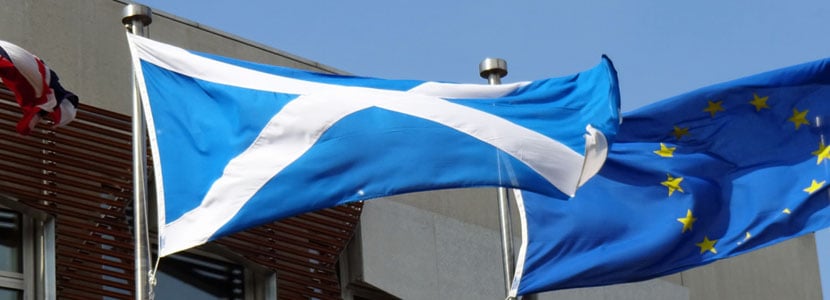
by David Gow
Editor of Sceptical.scot, Senior Adviser at Social Europe and Senior Adviser at Acumen Public Affairs. He is former European Business Editor of The Guardian and worked for The Scotsman and London Weekend Television.
17th March 2020
This article was first published by Scottish Centre on European Relations
Introduction
Such is the binary nature of political debate in Scotland that views on the economic prospects for an independent Scotland to join the European Union are overwhelmingly Manichean.
Either the country will sail through the accession process in a matter of months post-independence. Or the economic, fiscal and monetary obstacles will be so high it may never happen – and Scotland will forever be saddled with outsider status. A North Sea Belarus.
It should go without saying that neither of these extreme positions – ultra-independista and nec plus unionista – is based in reality. What matters is less the current state of the Scottish economy – hard to disentangle from a 313-year-old economic and monetary union – than what it might or could be x years from hence when or if Scotland is an independent country. And that is a big unknown.
One reason for this uncertainty is that (at the moment of writing) the UK government has published a negotiating mandate for the talks with the EU on future relations that puts the accent on divergence.
The more a post-Brexit UK, including willy nilly Scotland, pursues deliberate divergence the harder it will be for an independent Scotland to meet the criteria for (re)joining, although the Scottish government hopes to stay aligned to EU law in some devolved areas of policy including the environment. As a sub-state, albeit with devolved powers, Scotland has limited room for manoeuvre economically. It could easily be dragged down in any UK-wide recession.
And the longer this economic uncertainty goes on, and the lengthier the process of seeking and winning independence, it will become even more difficult to meet the specifically fiscal and monetary criteria for EU membership.
The State of Scotland
The Scottish Fiscal Commission delivered its latest 5-year forecasts for the Scottish economy in early February (post-Scottish budget, pre-UK budget), showing GDP growth a shade over 1% per annum. Tax revenues, however, show a much healthier upward trend, largely on the back of sustained wages growth bringing a higher income tax yield. But no forecast for the budget deficit is given. Equally, other neutral commentators such as the Fraser of Allander Institute are sceptical about the degree of wages growth forecast (3% a year roughly).
The budget deficit is a key number when it comes to accession to the EU but not as determinant as some commentators (disingenuously) suggest. In 2018-2019, the deficit, including a share of North Sea revenues, was 7% when the UK’s was 1.2%. The OBR forecasts it will hover around 6% up to 2023-24 – or the period when, on a generous time horizon, Scots might be waking up to being in an independent country. In comparison, the current eurozone government deficit is 0.7% and that of the EU28 0.9%, with the suggestion that this is an inappropriate straitjacket imposed by the Germans and other “frugals” when the eurozone economy faces recession. In Scotland, meanwhile, there is considerable debate over the true scale of the deficit upon independence and whether or how to bring it down to such low value.
The Scottish government, drawing on the report of the Sustainable Growth Commission, estimated[1] an inherited deficit in 2021-22 of 5.9% of GDP, assuming lower spending on defence, debt servicing and “some other services”. It says: “An independent Scotland would need tight public spending rules to bring the country’s deficit down from around 6% in 2021-22 to below 3% over a period of 10 years”. The 3% target is that set by the EU’s Stability & Growth Pact (SGP) aka Maastricht criteria. So far, there has been no credible indication of what policies, let alone concrete spending measures or cuts, would be put in place to achieve such an outcome. The Growth Commission proposed that total public spending should increase by 1% less than GDP for the first decade post-independence. As it assumed GDP growth of 1.5% a year, spending on public services and benefits would increase annually by just 0.5%. The Institute for Fiscal Studies observed: “Such an approach would see spending on public services and benefits fall by about 4% of GDP over that decade. Add on the growing amount the Scottish government would have to spend on servicing its increasing post-independence debt, and overall public spending and hence the deficit would fall by 3% of GDP. Together with some assumed but unspecified efficiency savings (0.3% of GDP), that brings the forecast deficit down to 2.6% of GDP one decade after Scottish independence.”[2] Of course, the Growth Commission is targeting 3% annual GDP growth which, if attainable (a big if), would imply a softer fiscal regime and easier path towards a sustainable deficit.
For the year to end-March 2019, UK government debt stood at 85.2% of GDP, a shade below that of the eurozone (EA19) at 86.1% in Q3 2019, and above that of the EU28 at 80.1% compared with the Maastricht reference value of 60%. Central government gross debt stood at £1.8 trillion at end-March 2019, but we have no idea what Scotland’s share of this would be. The 2013 Scottish government white paper, before the 2014 independence referendum, suggested this could be either via population share or aggregated fiscal deficit (starting arbitrarily at 1980-81 in that report or just prior to when North Sea oil revenues kicked in.)[3] Another suggestion[4] in that period was to follow the example of the Czechs and Slovaks during their ‘velvet divorce’ of 1993 and divide assets on a geographic basis (oil, say, in the Scottish case) and debt via the share of population. The Growth Commission suggests – somewhat airily – that national debt should “not increase” beyond 50% of GDP and stabilise at that level.
Meeting the criteria
Political commentators, often across the binary divide, confuse the criteria for joining the EU with those for adopting the single currency, the euro. There is no demand for an extant budget deficit of 3% or debt-to-GDP ratio of 60% for entry to the EU: these are, once again, the Stability and Growth Pact reference values, not a barrier as the Croatian case underlines and are more relevant (though not absolute) for adopting the euro. The Croats joined the EU in 2013 when their net government deficit was 5.3% after falling to as low as 2.4% in 2007 and rising to 7.9% in 2011 as the financial crisis and economic slump took their toll.
In other words, they had to show they were on a downward path and indeed the country registered a small surplus (0.2%) German-style in 2018, with similar ones projected for this year and next. The crucial point, however, is what happened post-accession. Croatia was rapidly, after its first 6 months only, put under the EU’s Excessive Deficit Procedure (EDP) and then carried out a fiscal squeeze to comply with the deficit conditions. So, an independent Scotland could ask for a transition period during which it would work towards meeting the Stability and Growth Pact targets, pointing out any progress already made but the Commission and the member states would decide whether progress towards the targets was adequate. And it and they could insist on a tight schedule.
Here the question is whether the Scottish polity, let alone populace, is aware of how severe the spending squeeze might have to be – coming not that long after a decade of austerity. Would an independent Scottish government and civil society be both able and willing to accept strict spending controls/cuts? The typical answer that independence will, by itself, trigger an entirely different set of (positive) economic outcomes may be wishful thinking. As matters stand, we simply have no way of knowing whether that’s likely or not.
Equally, there is no doubt that an independent Scotland would have to indicate its willingness to join the euro – at an unspecified point. Eight EU countries, including Denmark, which has an opt-out, and Sweden, which does not, are not in the single currency. In this case, the five convergence criteria – on inflation, deficit, borrowing costs – are stricter than for entering the EU per se.
What matters more is the currency question itself, arguably the one that undermined Alex Salmond in the 2014 independence referendum. His successor, Nicola Sturgeon, simply asserts that “… it is not true to say that we would have had to have established an independent currency before joining the European Union.” She abides by the Growth Commission process of ‘sterlingisation’ or sharing sterling before adopting an independent Scottish currency further down the line. That may be problematic. Initially, at least, the Scottish Central Bank (as proposed by the Growth Commission) would not set its own monetary policy, including interest rates – unlike, say, the Slovenes which set theirs up as early as 1991 in the break-up of Yugoslavia. Slovenia entered the EU on January 1 2004 and joined the euro exactly three years later. But, two decades later at least, a newly independent Scotland might face a different – and very political – interpretation of whether it met the economic criteria, including the key one of “macroeconomic stability (including adequate price stability as well as sustainable public finances and external accounts)”.
Conclusion
The national debate about an independent Scotland joining the EU, broken off to all extents and purposes in 2014, has been rebooted but at a low energy level within the Scottish government and Holyrood. If it is to be meaningful, there needs to be far more active engagement by both the political class and civil society. At the core of this national debate must be the economy and whether it can be brought to a position where Scotland can and will meet the criteria for accession if it so wishes. So far, it does not meet those economic criteria in their entirety – notably monetary policy as well as exchange rate, as set out in Chapter 17 – but the true state of the economy if and when the Scottish government embarks upon the EU accession process may be more favourable then.
Ultimately, this will be a political decision. And the EU holds many if not most of the cards. As the latest iteration of enlargement policy spells out: “The Union’s capacity to absorb new members, while maintaining the momentum of European integration, is also an important consideration. The EU reserves the right to decide when a candidate country has met these criteria and when the EU is ready to accept the new member.”
Notes
[1] https://www.gov.scot/binaries/content/documents/govscot/publications/foi-eir-release/2018/09/foi-18-02282/documents/foi-18-02282—summary-report/foi-18-02282—summary-report/govscot%3Adocument/FOI-18-02282%2B-%2Bsummary%2Breport.pdf
[2] https://www.ifs.org.uk/publications/13072
[3] https://www.centreonconstitutionalchange.ac.uk/opinions/scottish-independence-debt-and-assets
[4] https://www.centreonconstitutionalchange.ac.uk/opinions/scottish-independence-and-uks-debt-burden





